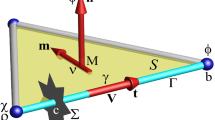Abstract
The equations governing the time evolution of an ideal fluid in material coordinates are expressed as an unconstrained canonical Hamiltonian system. The incompressibility of the flow is consequent upon certain first integrals of the motion. The variable conjugate to the configuration field is not the usual linear momentum, but is instead a quantity that is related to linear momentum through an auxiliary scalar field whose time derivative is the pressure. The definition of the Hamiltonian involves a minimization with respect to this auxiliary field. The method of derivation may be generally applied to obtain unconstrained Hamiltonian descriptions of Lagrangian field equations subject to pointwise constraints.
Similar content being viewed by others
References
Arnold, V.I., Kozlov, V.V., Neishtadt, A.I.: Mathematical aspects of classical and celestial mechanics. In: Arnold, V.I. (ed.) Dynamical Systems III, Encyclopaedia of Mathematical Sciences, vol. 3. Berlin, Heidelberg, New York Springer-Verlag, 1988 (See pp. 31–38)
Benjamin, T.B.: Impulse, flow force and variational principles. IMA J. Appl. Math.32, 3–68 (1984)
Benjamin, T.B., Bridges, T.J.: Reappraisal of the Kelvin-Helmholtz problem. Part 1, Hamiltonian structure. Preprint 1993
Bloch, A., Krishnaprasad, P.S., Marsden, J.E., Ratiu, T.S.: Dissipation induced instabilities. Ann. Inst. H. Poincaré, Anal. Non Linéaire11, 1–54 (1994)
Buttke, T.F.: Velicity methods: Lagrangian numerical methods which preserve the Hamiltonian structure of incompressible fluid flow. In: Beale, J.T., Cottet, G.H., Huberson, S. (eds.) Vortex Flows and Related Numerical Methods. NATO Adv. Sci. Inst. Ser. C Math. Phys. Sci. vol. 395, pp. 39–57. Dordrecht, Boston, London: Kluwer, 1993
Chorin, A.: Vortex Phase Transitions in 2 1/2 dimensions. Lawrence Berekeley Laboratory Report LBL-34769 (1993)
Dichmann, D.J., Maddocks, J.H., Pego, R.L.: Hamiltonian dynamics of an elastica and the stability of solitary waves. Arch. Rat. Mech. Anal. (submitted)
Dirac, P.A.M.: On generalized Hamiltonian dynamics. Can. J. Math.2, 129–148 (1950)
Holm D.D., Marsden, J.E., Ratiu, T.S.: Hamiltonian structure of continuum mechanics in material, inverse material, spatial and convective representations In: Hamiltonian structure and Lyapunov stability for ideal continuum mechanics. Sem. Math. Sup. vol.100. University of Montreal Press, 1986
Kuz'min, G.A.: Ideal incompressible hydrodynamics in terms of the vortex momentum density. Phys. Lett.96A, 88–90 (1983)
Maddocks, J.H. & Overton, M.L.: Stability theory for dissipatively perturbed Hamiltonian systems. Comm. Pure Appl. Math. (to appear)
Osedelets, V.I.: On a new way of writing the Navier-Stokes equation. The Hamiltonian formalism. Comm. Moscow Math. Soc. (1988) [transl.: Russ. Math. Surveys44, 210–211 (1989)]
Serrin, J.: Mathematical principles of classical fluid mechanics. In: Handbuch der Physik, Vol. VIII/1. Berlin, Heidelberg, New York: Springer-Verlag, 1959, pp. 125–263.
Author information
Authors and Affiliations
Additional information
Communicated by S.-T. Yau
Rights and permissions
About this article
Cite this article
Maddocks, J.H., Pego, R.L. An unconstrained Hamiltonian formulation for incompressible fluid flow. Commun.Math. Phys. 170, 207–217 (1995). https://doi.org/10.1007/BF02099446
Received:
Issue Date:
DOI: https://doi.org/10.1007/BF02099446




